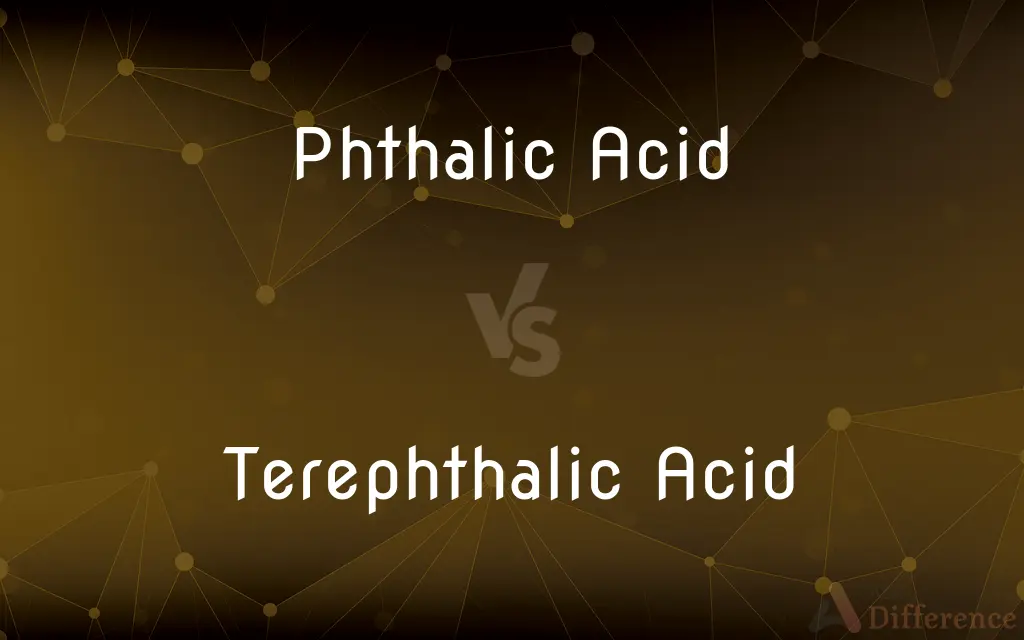Phthalic Acid vs. Terephthalic Acid — What's the Difference?
By Tayyaba Rehman — Published on November 11, 2023
Phthalic Acid is an aromatic dicarboxylic acid with adjacent carboxyl groups, while Terephthalic Acid has carboxyl groups in a para position. Both are used in polymer synthesis but have different structures and applications.

Difference Between Phthalic Acid and Terephthalic Acid
Table of Contents
ADVERTISEMENT
Key Differences
Structural Distinctions: Phthalic Acid, an aromatic dicarboxylic acid, possesses carboxyl groups located adjacently on the benzene ring. Conversely, Terephthalic Acid's carboxyl groups are in a para position, separated by two carbon atoms.
Applications: Phthalic Acid is pivotal in producing phthalate esters, which are primarily plasticizers in PVC. Terephthalic Acid is essential for producing polyethylene terephthalate (PET), a commonly used polymer in textiles and packaging.
Reactivity: Due to its structural arrangement, Phthalic Acid might showcase different reactivity patterns in chemical reactions compared to Terephthalic Acid. This distinction influences their respective uses in the chemical industry.
Derivatives and Salts: While both acids form anhydrides and salts, their derivatives differ because of their structural variances. For example, phthalic anhydride derived from Phthalic Acid is crucial in industrial syntheses, whereas Terephthalic Acid is known for its purified form, purified terephthalic acid (PTA).
Toxicity and Environmental Impact: Both acids, when utilized in polymers, have concerns regarding their environmental footprints. However, Phthalic Acid derivatives, especially some phthalates, have come under scrutiny for potential health impacts, unlike Terephthalic Acid used in PET, considered more benign.
ADVERTISEMENT
Comparison Chart
Structure
Carboxyl groups adjacent
Carboxyl groups in para position
Main Use
Plasticizers in PVC
Polyethylene terephthalate (PET) production
Reactivity
Reacts based on adjacent carboxyl groups
Reacts based on para-positioned carboxyl groups
Key Derivative
Phthalic anhydride
Purified terephthalic acid (PTA)
Toxicity Concerns
Some derivatives have health concerns
Generally considered more benign
Compare with Definitions
Phthalic Acid
A benzenedicarboxylic acid with ortho-positioned carboxyl groups.
Phthalic Acid, when dehydrated, forms phthalic anhydride.
Terephthalic Acid
Known for its high purity form, PTA.
The production of PTA from Terephthalic Acid is a significant industrial process.
Phthalic Acid
An aromatic dicarboxylic acid with adjacent carboxyl groups.
Phthalic Acid is a precursor to widely used phthalate plasticizers.
Terephthalic Acid
An aromatic dicarboxylic acid with carboxyl groups in a para position.
Terephthalic Acid is a vital ingredient in PET polymer synthesis.
Phthalic Acid
Used to derive plasticizers in PVC applications.
Manufacturers incorporate Phthalic Acid derivatives to enhance the flexibility of certain plastics.
Terephthalic Acid
A white crystalline compound utilized in polymer production.
The global production of Terephthalic Acid has seen consistent growth due to the expansion of the PET market.
Phthalic Acid
A white crystalline organic compound.
Phthalic Acid, when exposed to heat, can sublimate.
Terephthalic Acid
Used predominantly in textile and packaging industries.
The demand for Terephthalic Acid has surged due to PET's popularity in various industries.
Phthalic Acid
Known for its role in the creation of phthalate esters.
Certain phthalates derived from Phthalic Acid have been flagged for their potential endocrine-disrupting properties.
Terephthalic Acid
Possesses a benzene ring with two carboxyl groups separated by two carbons.
Terephthalic Acid's distinct structure differentiates it from other dicarboxylic acids.
Common Curiosities
How do Phthalic Acid and Terephthalic Acid structurally differ?
Phthalic Acid has adjacent carboxyl groups, while Terephthalic Acid's are in a para position.
What's a common use for Phthalic Acid?
It's primarily used to produce phthalate esters, plasticizers in PVC.
Are there toxicity concerns with Phthalic Acid?
Some of its derivatives, like certain phthalates, have raised health concerns.
Which acid is used more in the polymer industry?
Terephthalic Acid, due to its role in PET production.
Where is Terephthalic Acid predominantly used?
In producing polyethylene terephthalate (PET) for textiles and packaging.
Are both acids naturally occurring?
Both are primarily produced industrially, though trace amounts might occur naturally.
Which industries should be concerned about Phthalic Acid's potential health impacts?
Industries using phthalate plasticizers, especially in children's products or food packaging.
Do both acids have anhydride forms?
Yes, Phthalic Acid forms phthalic anhydride, and Terephthalic Acid can also form an anhydride.
How are these acids typically synthesized?
Through various chemical processes, often involving xylene or naphthalene.
Is Terephthalic Acid considered environmentally safe?
It's generally more benign, especially when used in PET.
How do the prices of these acids typically compare?
Market dynamics, demand, and production costs influence their prices, which can vary over time.
How does Phthalic Acid's reactivity differ from Terephthalic Acid?
Their different structural carboxyl group positions influence their reactivity.
Is purified terephthalic acid (PTA) the same as Terephthalic Acid?
PTA is a high-purity form of Terephthalic Acid.
Are there alternatives to these acids in their respective industries?
Yes, but they dominate due to their efficacy and cost-effectiveness.
How do the environmental impacts of these acids' derivatives compare?
Terephthalic Acid (PET) is seen as more benign than some Phthalic Acid derivatives.
Share Your Discovery

Previous Comparison
Protein Kinase A vs. Protein Kinase C
Next Comparison
SP Recording vs. LP RecordingAuthor Spotlight
Written by
Tayyaba RehmanTayyaba Rehman is a distinguished writer, currently serving as a primary contributor to askdifference.com. As a researcher in semantics and etymology, Tayyaba's passion for the complexity of languages and their distinctions has found a perfect home on the platform. Tayyaba delves into the intricacies of language, distinguishing between commonly confused words and phrases, thereby providing clarity for readers worldwide.












































